Deep Neural Network-Based Flood Monitoring System Fusing RGB and LWIR Cameras for Embedded IoT Edge Devices
Abstract
1. Introduction
- (1)
- To the best of our knowledge, this is a novel system to monitor floods using a multimodal camera sensor composed of RGB and LWIR. This multimodal sensor-based approach improved the performance of water segmentation for night images.
- (2)
- For edge computing, we applied a network slimming method to DeepLabV3+, a semantic segmentation network that segments water in RGB and LWIR fused images. The method resulted in a significant reduction in processing time without degrading performance.
- (3)
- To verify the practicality and effectiveness of the proposed method, we demonstrated it in embedded using Qualcomm’s SoC (System on Chip).
- (4)
- A flood warning system module based on a mobile message service was built and demonstrated.
2. Related Works
3. Flood Monitoring System
3.1. Overview
3.2. Alignment of RGB and LWIR Images
3.3. Semantic Segmentation: DeepLabv3+
3.4. Network Slimming and Embedding
3.5. Flood Warning Module
4. Experiments
4.1. Dataset
4.2. Experimental Details
4.3. Results on the Effect of LWIR Data
4.4. Results on Edge Device
4.5. Results for Warning Message
5. Conclusions
Author Contributions
Funding
Data Availability Statement
Conflicts of Interest
References
- Khan, A.; Gupta, S.; Gupta, S.K. Multi-hazard disaster studies: Monitoring, detection, recovery, and management, based on emerging technologies and optimal techniques. Int. J. Disaster Risk Reduct. 2020, 47, 101642. [Google Scholar] [CrossRef]
- Khan, A.; Gupta, S.; Gupta, S.K. Emerging UAV technology for disaster detection, mitigation, response, and preparedness. J. Field Robot. 2022, 39, 905–955. [Google Scholar] [CrossRef]
- UNDRR. The Human Cost of Disasters—An Overview of the Last 20 Years 2000–2019; UNDRR: Geneva, Switzerland, 2020. [Google Scholar]
- Anbarasan, M.; Muthu, B.; Sivaparthipan, C.B.; Sundarasekar, R.; Kadry, S.; Krishnamoorthy, S.; Samuel, R.D.; Dasel, A.A. Detection of flood disaster system on IoT, big data and convolutional deep neural network. Comput. Commun. 2020, 150, 150–157. [Google Scholar] [CrossRef]
- Prakash, C.; Barthwal, A.; Acharya, D. FLOODWALL: A Real-Time Flash Flood Monitoring and Frecasting System Using IoT. IEEE Sens. J. 2023, 23, 787–799. [Google Scholar] [CrossRef]
- Chowdhury, T.; Rahnemoonfar, M.; Murphy, R.; Fernandes, O. Comprehensive Semantic Segmentation on High Resolution UAV imagery for Natural Disaster Damage Assessment. In Proceedings of the 2020 IEEE International Conference on Big Data, Atlanta, GA, USA, 10–13 December 2020. [Google Scholar]
- Hernández, D.; Cecilia, J.M.; Cano, J.C.; Calafate, C.T. Flood Detection Using Real-Time Image Segmentation from Unmanned Aerial Vehicles on Edge-Computing Platform. Remote Sens. 2022, 14, 223. [Google Scholar] [CrossRef]
- Puspitasri, R.D.; Annisa, F.Q.; Ariyanto, D. Flooded Area Segmentation on Remote Sensing Image from Unmanned Aerial Vehicles (UAV) using DeepLabV3 and EfficientNet-B4 Model. In Proceedings of the 2023 International Conference on Computer, Control, Informatics and Its Applications, Bandung, Indonesia, 4–5 October 2023; pp. 216–220. [Google Scholar]
- Basnyat, B.; Roy, N.; Gangopadhyay, A. Flood Detection using Semantic Segmentation and Multimodal Data Fusion. In Proceedings of the 6th IEEE International Workshop on Pervasive Context-Aware Smart Cities and Intelligent Transport System, Kassel, Germany, 22–26 March 2021; pp. 135–140. [Google Scholar]
- Lopez-Fuentes, L.; Rossi, C.; Skinnemoen, H. River segmentation for flood monitoring. In Proceedings of the 2017 IEEE International Conference on Big Data, Boston, MA, USA, 11–14 December 2017; pp. 3746–3749. [Google Scholar]
- Baydargil, H.B.; Park, J.; Shin, H.S.; Park, K. Water Flow Detection Using Deep Convolutional Encoder-decoder Architecture. In Proceedings of the 2018 18th International Conference on Control, Automation and Systems, PyeongChang, Republic of Korea, 17–20 October 2018; pp. 841–843. [Google Scholar]
- Akiyama, T.S.; Marçato Junior, J.; Goncalves, W.N.; Bressan, P.O.; Eltner, A.; Binder, F.; Singer, T. Deep Learning Applied to Water Segmentation. Int. Arch. Photogramm. Remote Sens. Spat. Inf. Sci. 2020, XLIII-B2-2020, 1189–1193. [Google Scholar]
- Vitry, M.M.; Kramer, S.; Wegner, J.D.; Leitão, J.P. Scalable flood level trend monitoring with surveillance cameras using a deep convolutional neural network. Hydrol. Earth Syst. Sci. 2019, 23, 4621–4634. [Google Scholar] [CrossRef]
- Borwarninginn, P.; Haga, J.H.; Kusakunniran, W. Water Level Detection from CCTV Cameras using a Deep Learning Approach. In Proceedings of the 2020 IEEE Region 10 Conference, Osaka, Japan, 16–19 November 2020; pp. 1283–1288. [Google Scholar]
- Vandaele, R.; Dance, S.L.; Ojha, V. Automated Water Segmentation and River Level Detection on Camera Images Using Transfer Learning. Pattern Recognit. 2021, 12544, 232–245. [Google Scholar]
- Muhadi, N.A.; Abdullah, A.F.; Bejo, S.K.; Mahadi, M.R.; Mijic, A. Deep Learning Semantic Segmentation for Water Level Estimation Using Surveillance Camera. Appl. Sci. 2021, 11, 9691. [Google Scholar] [CrossRef]
- Fernandes Junior, F.E.; Nonato, L.G.; Ranieri, C.M. Memory-Based Pruning of Deep Neural Networks for IoT Devices Applied to Flood Detection. Sensors 2021, 21, 7506. [Google Scholar] [CrossRef] [PubMed]
- Lee, Y.J.; Jung, H.G.; Suhr, J.K. Semantic Segmentation Network Slimming and Edge Deployment for Real-time Forest Fire or Flood Monitoring System Using Unmanned Aerial Vehicles. Electronics 2023, 12, 4795. [Google Scholar] [CrossRef]
- Hartley, R.; Zisserman, A. Multiple View Geometry in Computer Vision, 2nd ed.; Cambridge University Press: Cambridge, UK, 2004; p. 36. [Google Scholar]
- Chen, L.-C.; Zhu, Y.; Papandreou, G.; Schroff, F.; Adam, H. Encoder-Decoder with Atrous Separable Convolution for Semantic Image Segmentation. In Proceedings of the European Conference on Computer Vision (ECCV), Munich, Germany, 8–14 September 2018; pp. 801–818. [Google Scholar]
- Chen, L.; Papandreou, G.; Kokkinos, I.; Murphy, K.; Yuille, A.L. Semantic Image Segmentation with Deep Convolutional Nets and Fully Connected CRFs. arXiv 2014, arXiv:1412.7062. [Google Scholar]
- Chen, L.; Papandreou, G.; Kokkinos, I.; Murphy, K.; Yuille, A.L. DeepLab: Semantic Image Segmentation with Deep Convolutional Nets, Atrous Convolution, and Fully Connected CRFs. IEEE Trans. Pattern Anal. Mach. Intell. 2018, 40, 834–848. [Google Scholar] [CrossRef] [PubMed]
- Chen, L.; Papandreou, G.; Schroff, F.; Adam, H. Rethinking Atrous Convolution for Semantic Image Segmentation. arXiv 2017, arXiv:1706.05587v3. [Google Scholar]
- Liu, Z.; Li, J.; Shen, Z.; Huang, G.; Yan, S.; Zhang, C. Learning Efficient Convolutional Networks through Network Slimming. In Proceedings of the 2017 IEEE International Conference on Computer Vision, Venice, Italy, 22–29 October 2017; pp. 2755–2763. [Google Scholar]
- Qualcomm Neural Processing SDK. Available online: https://developer.qualcomm.com/software/qualcomm-neural-processing-sdk (accessed on 8 April 2024).
- Qualcomm Hexagon 685 DSP Is a Boon for Machine Learning. Available online: https://www.xda-developers.com/qualcomm-snapdragon-845-hexagon-685-dsp/ (accessed on 8 April 2024).
- Public Data Portal. Available online: https://www.data.go.kr/en/index.do (accessed on 8 April 2024).
- Rural Agricultural Water Resource Information System. Available online: https://rawris.ekr.or.kr/main.do (accessed on 8 April 2024).
- Sony IMX334. Available online: https://www.framos.com/wp-content/uploads/FSM-IMX334-Datasheet.pdf (accessed on 17 June 2024).
- Lepton 3.5 Module. Available online: https://www.flir.eu/products/lepton/?model=500-0771-01&vertical=microcam&segment=oem (accessed on 17 June 2024).

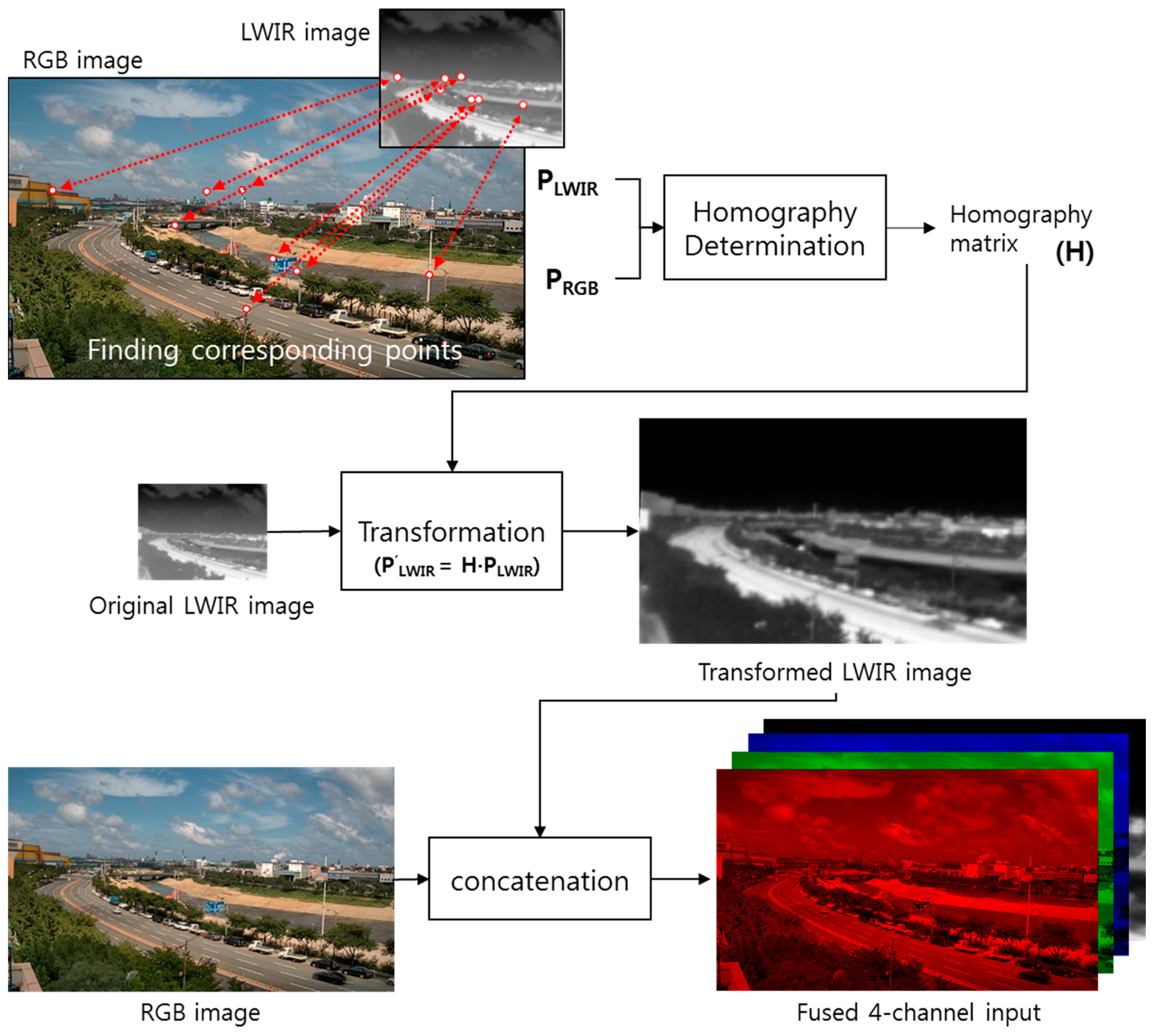





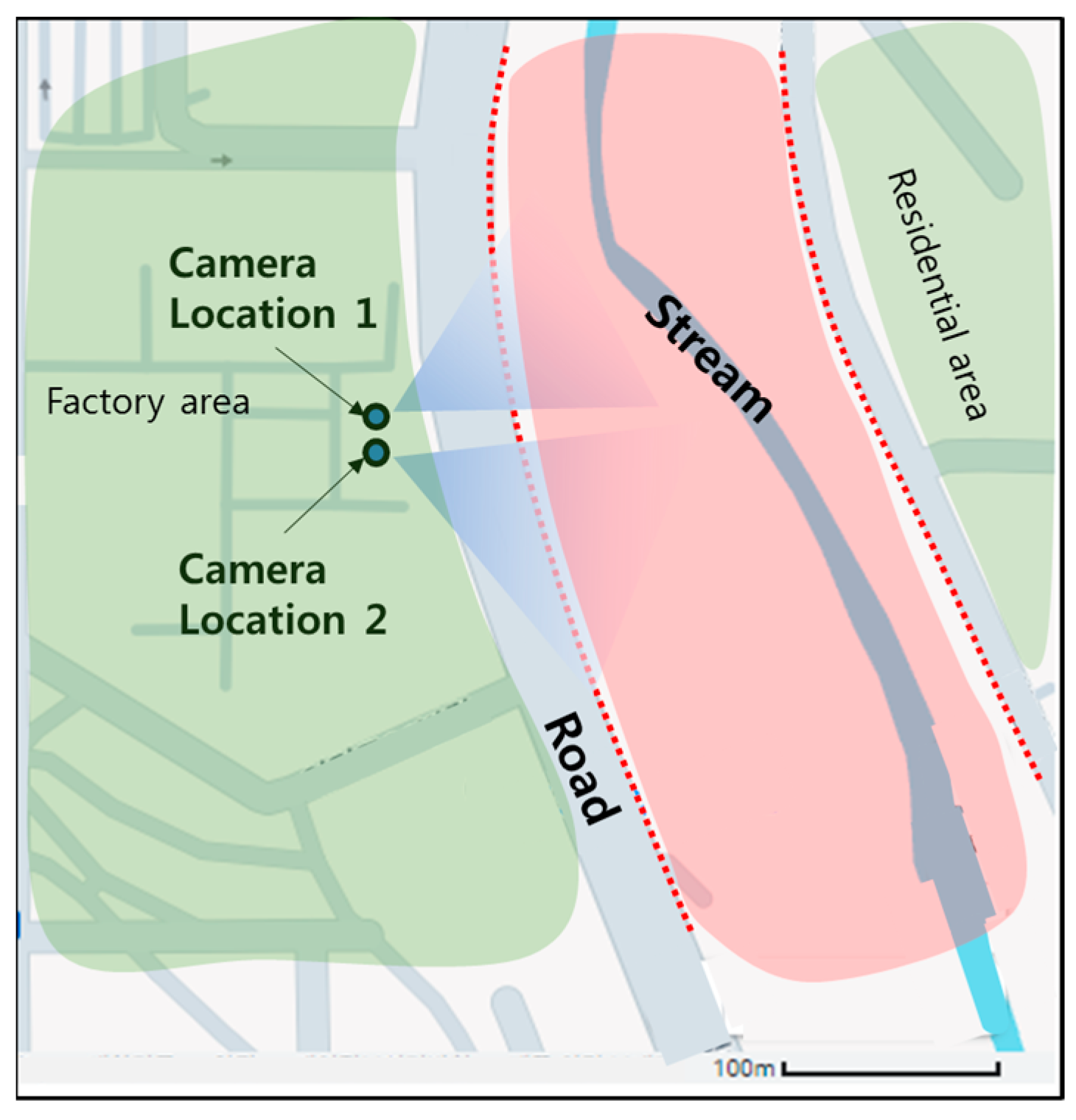

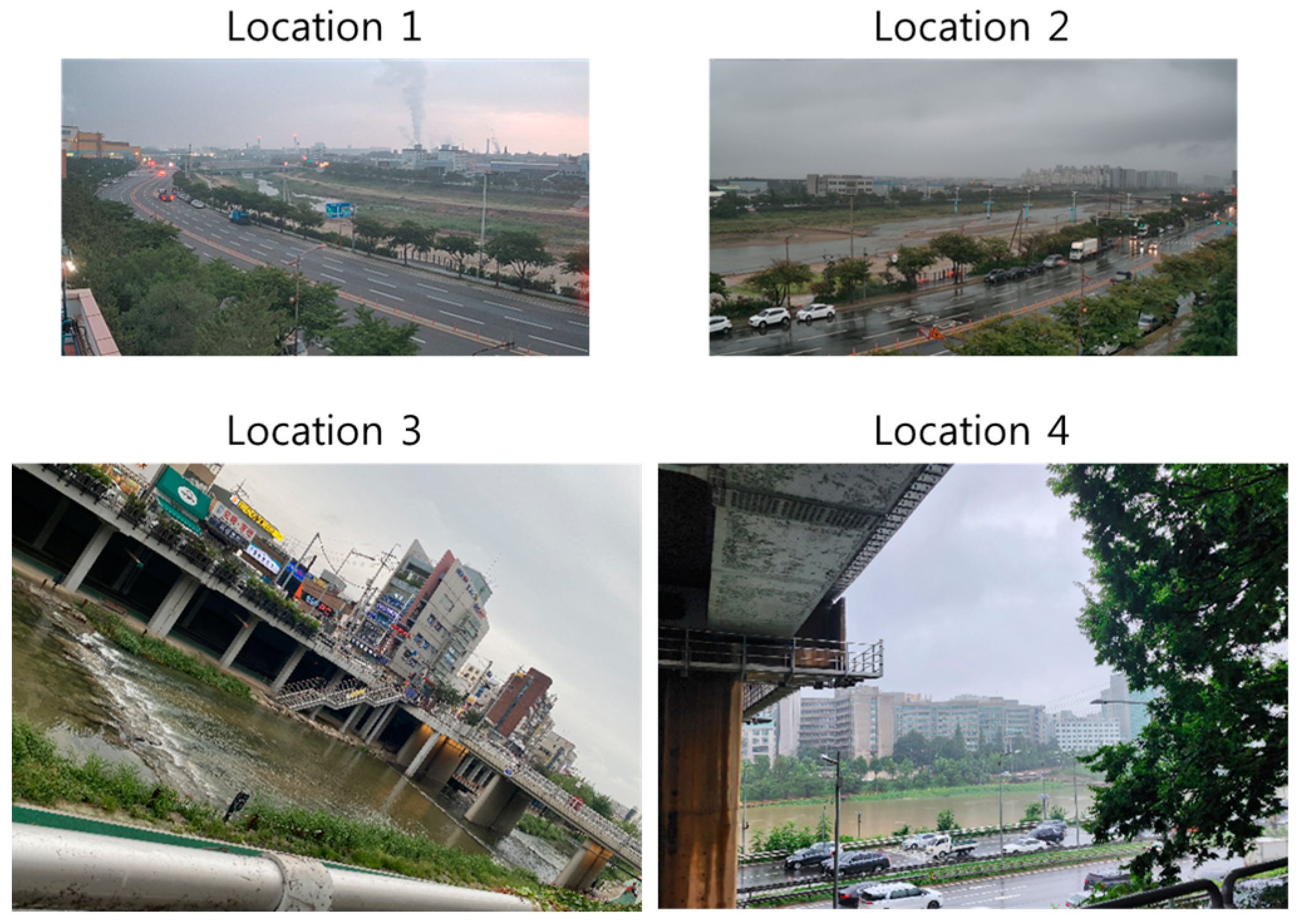
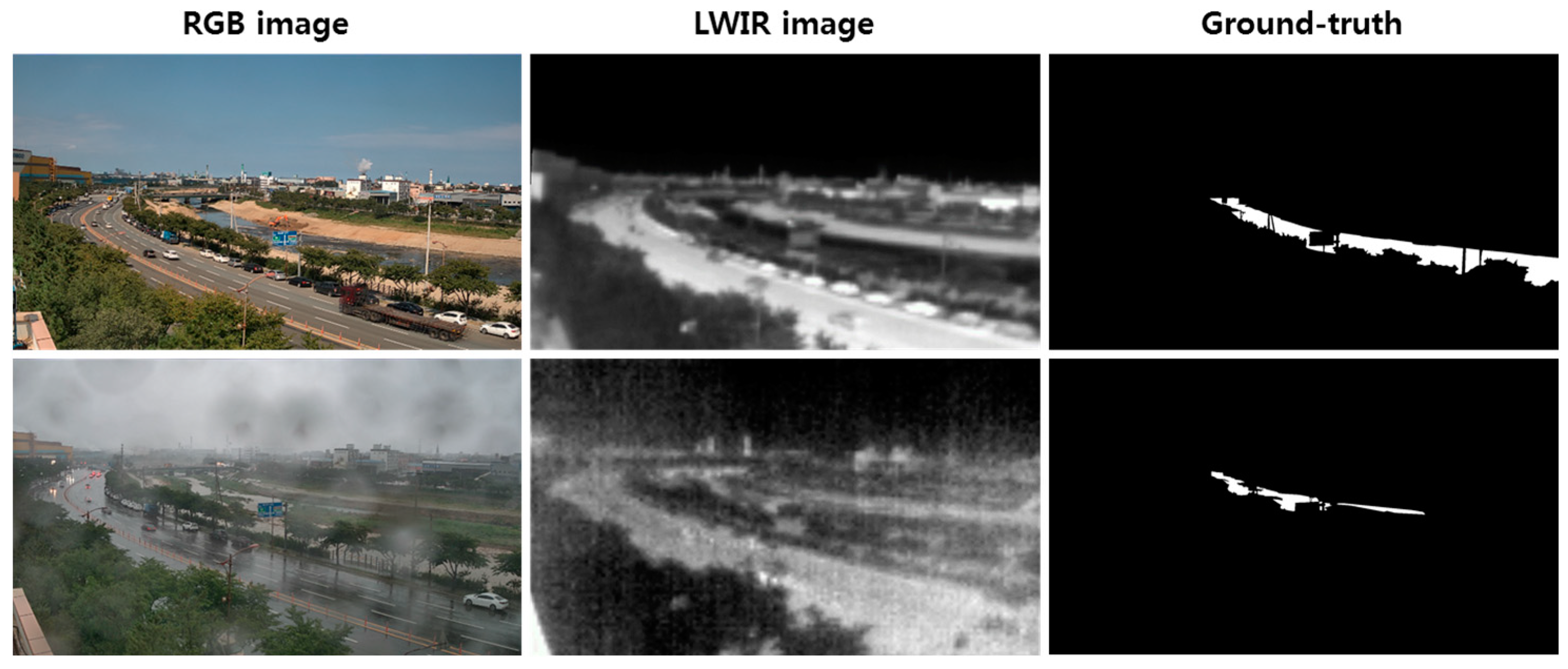
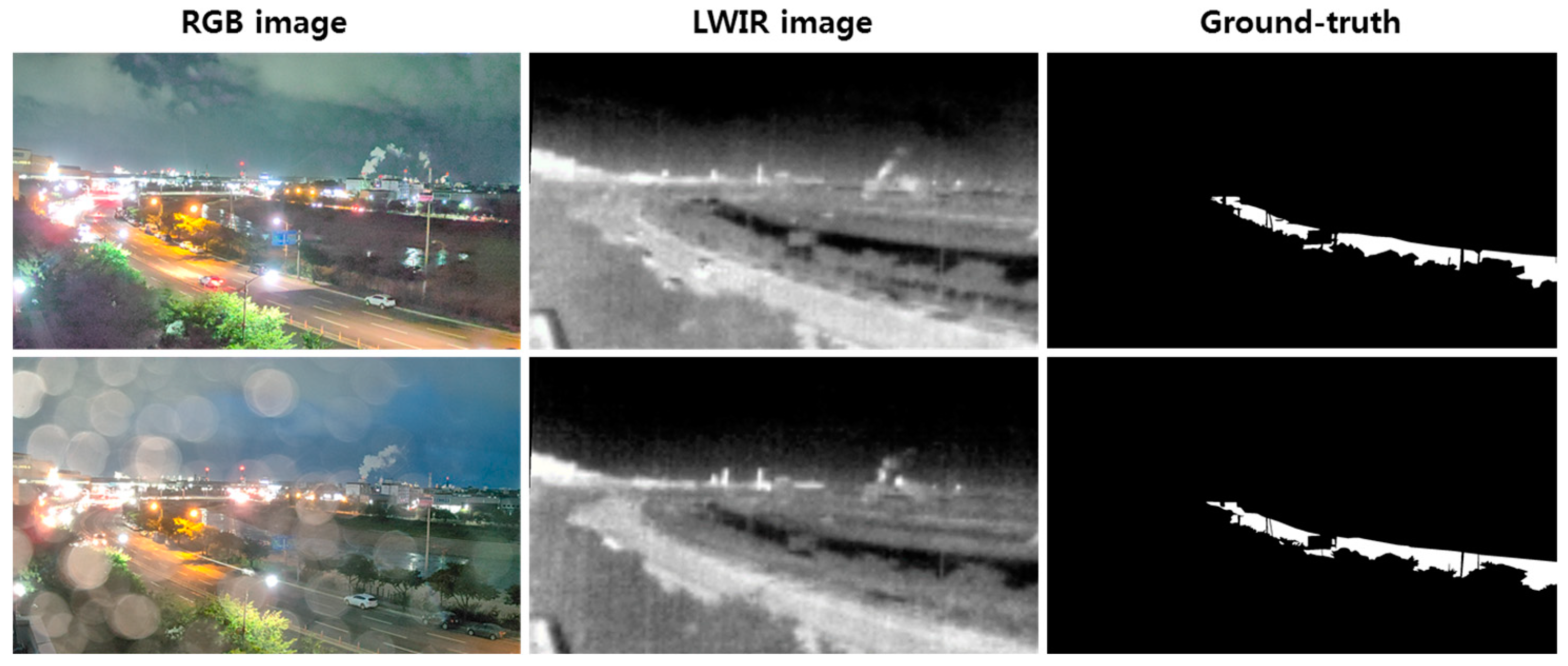
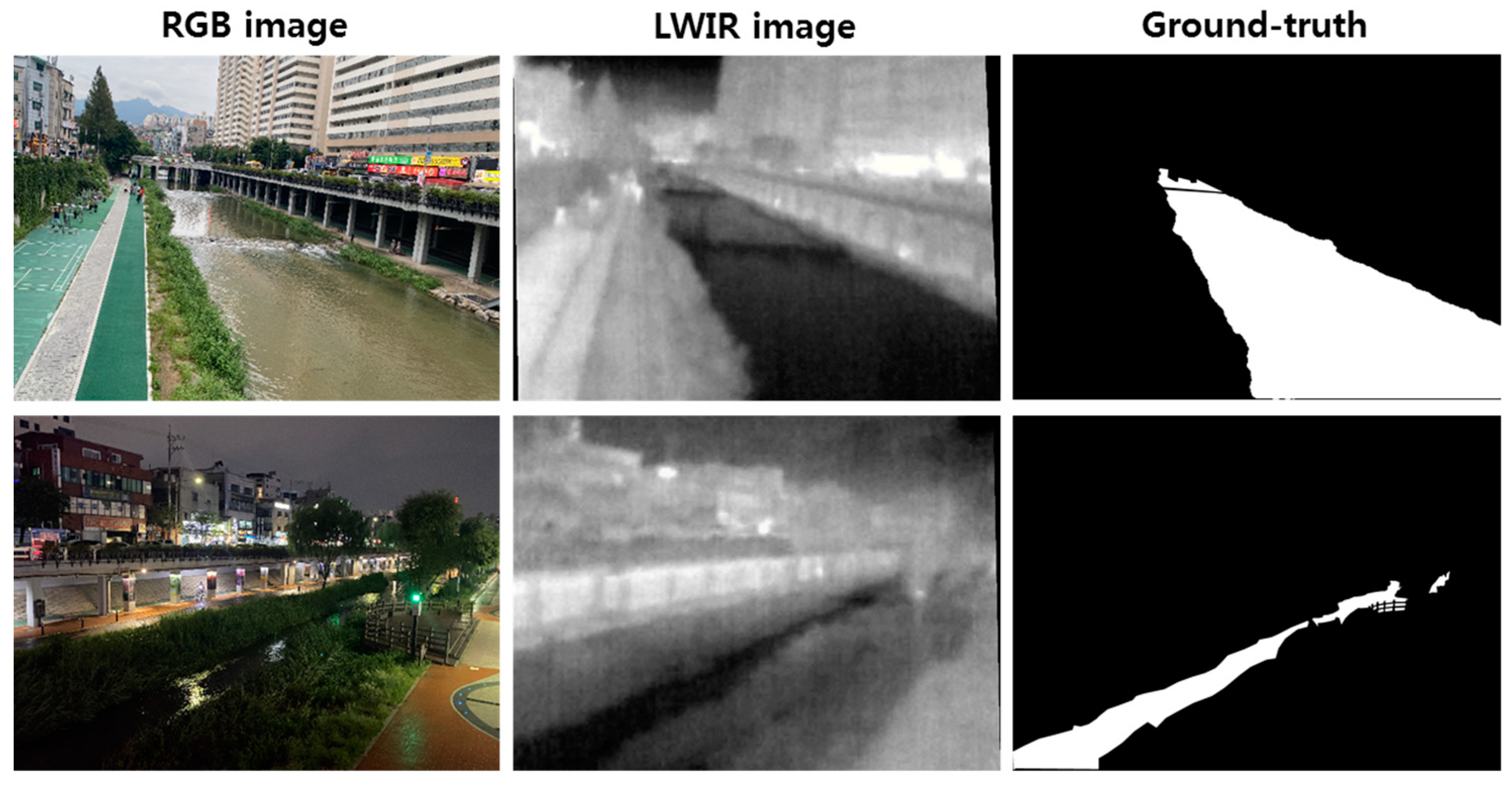
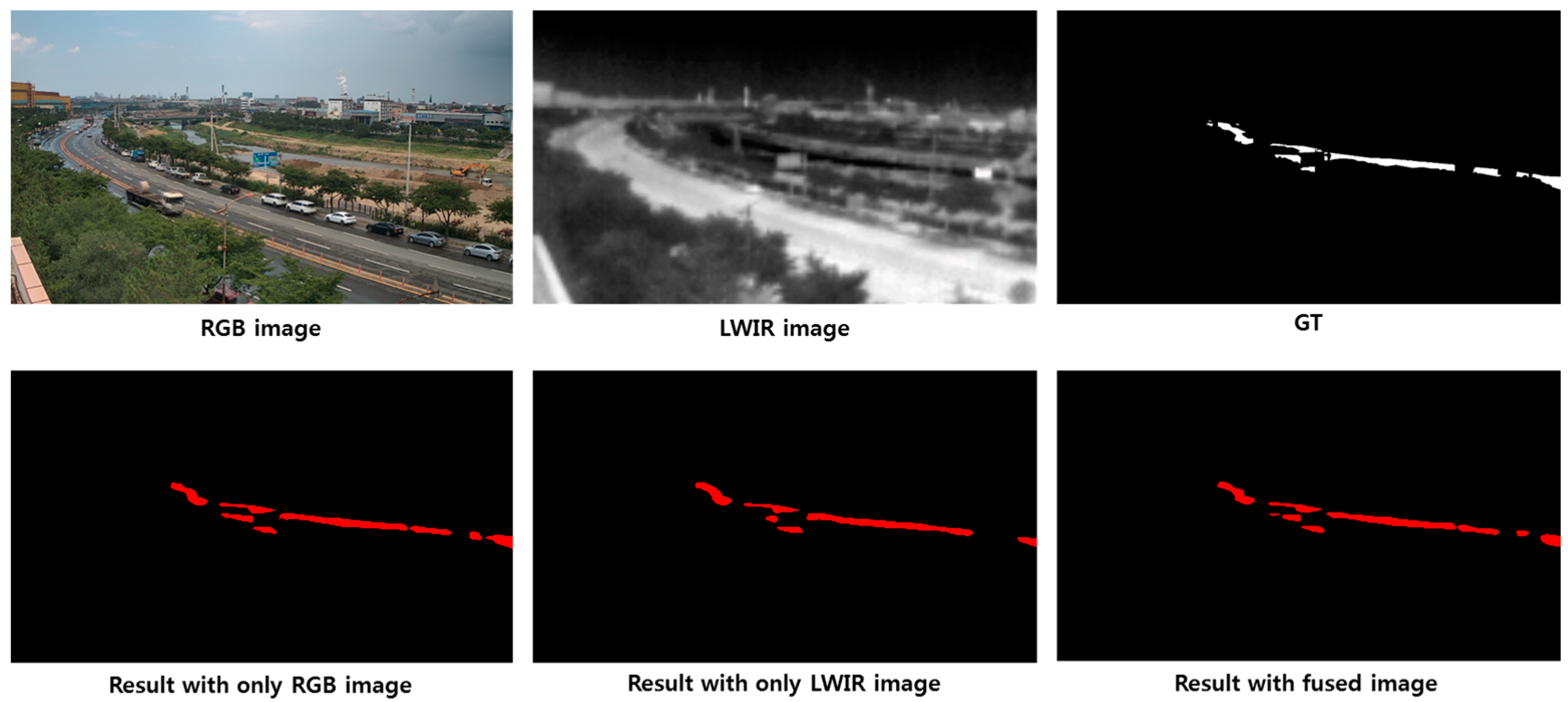
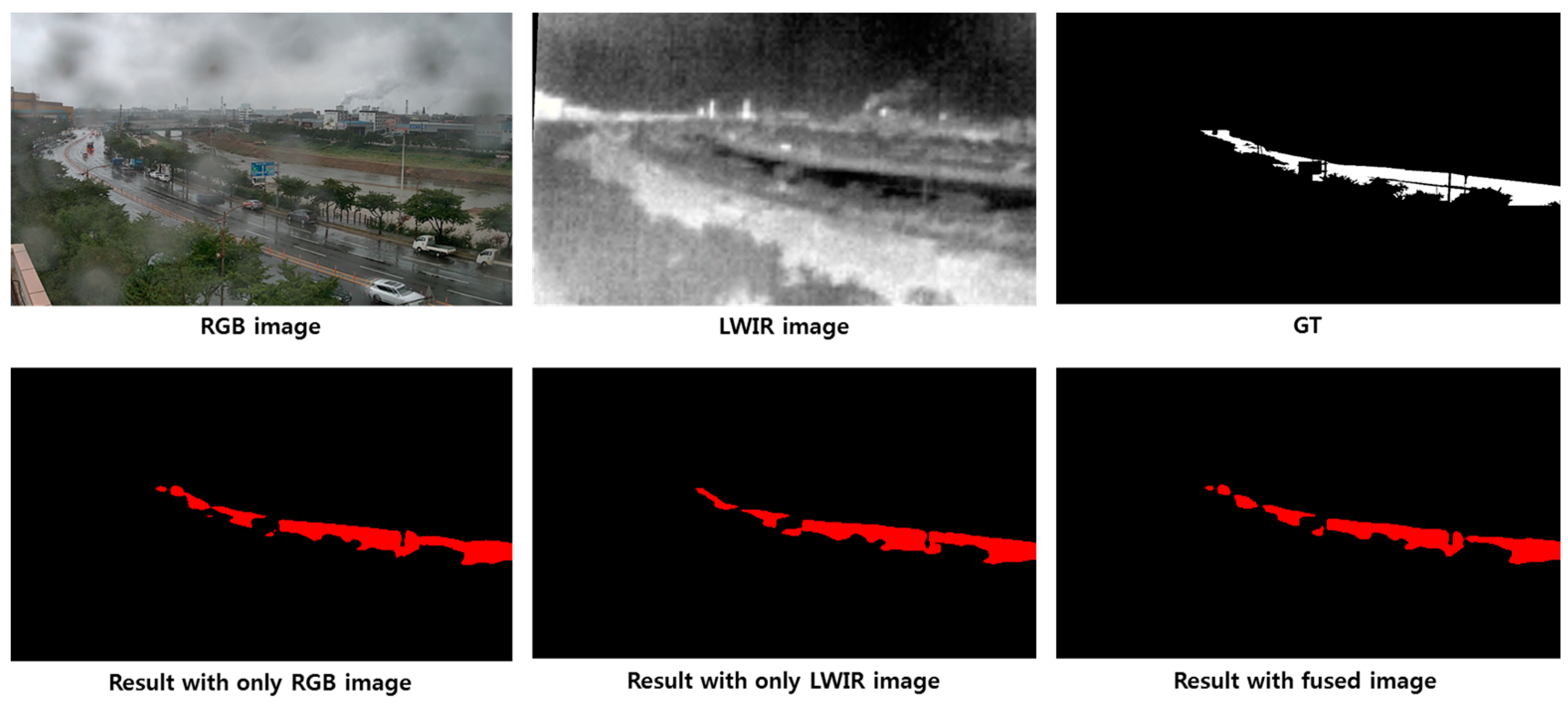

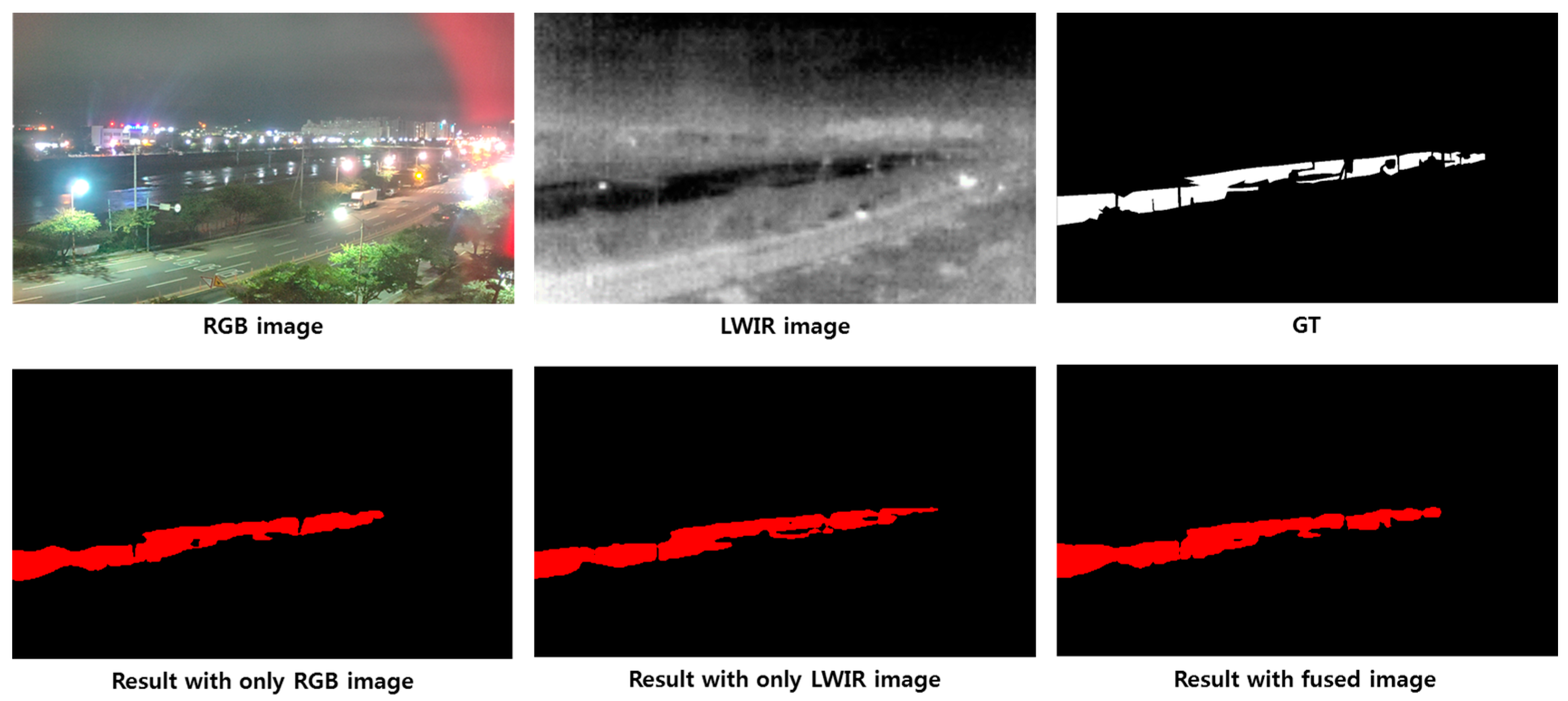
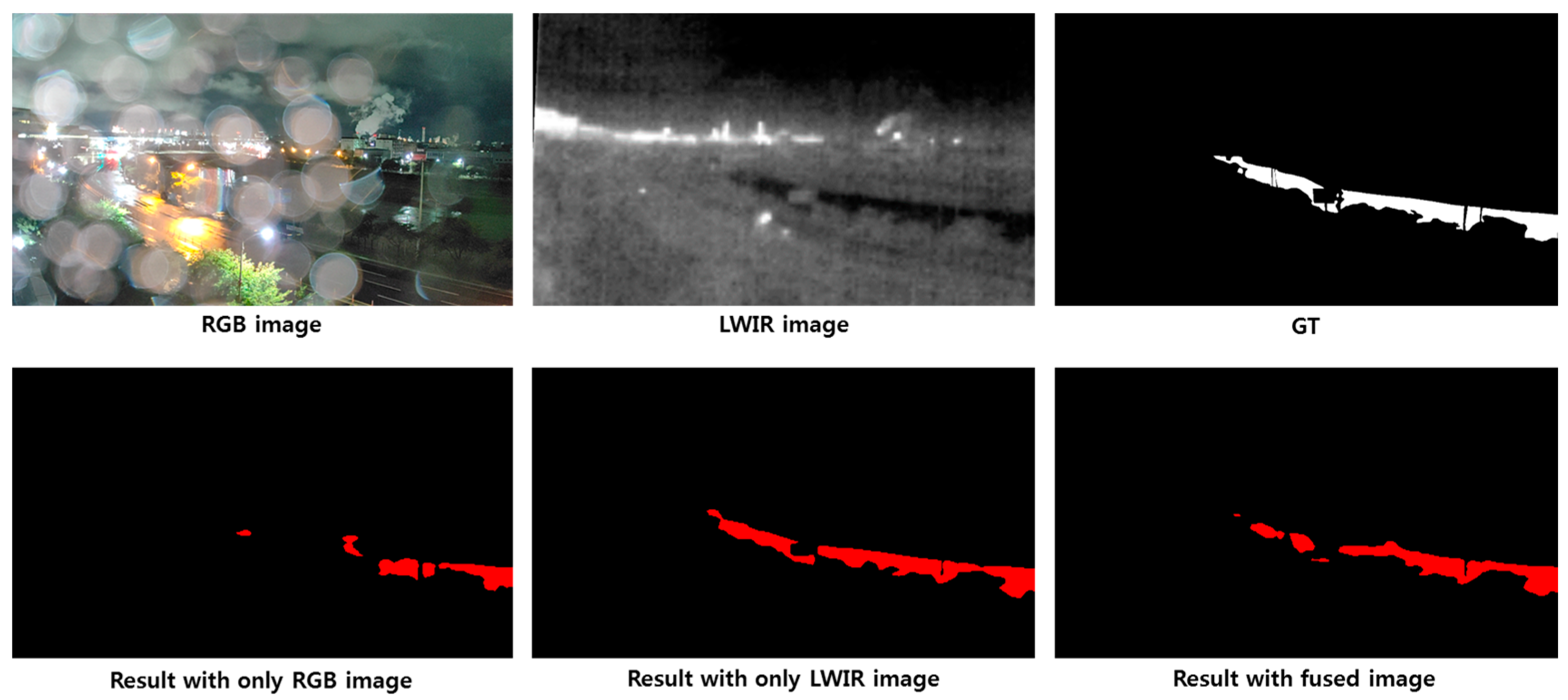

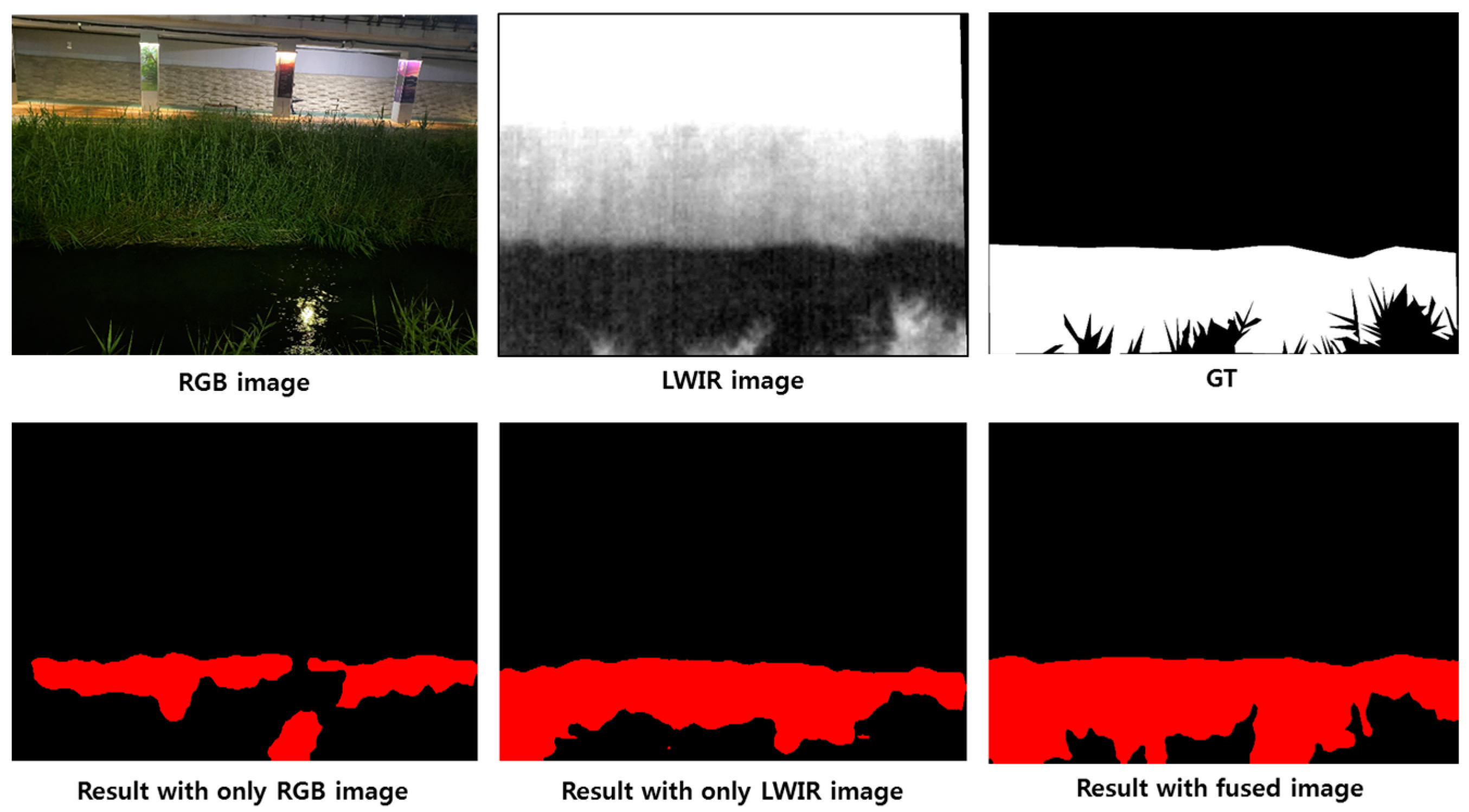
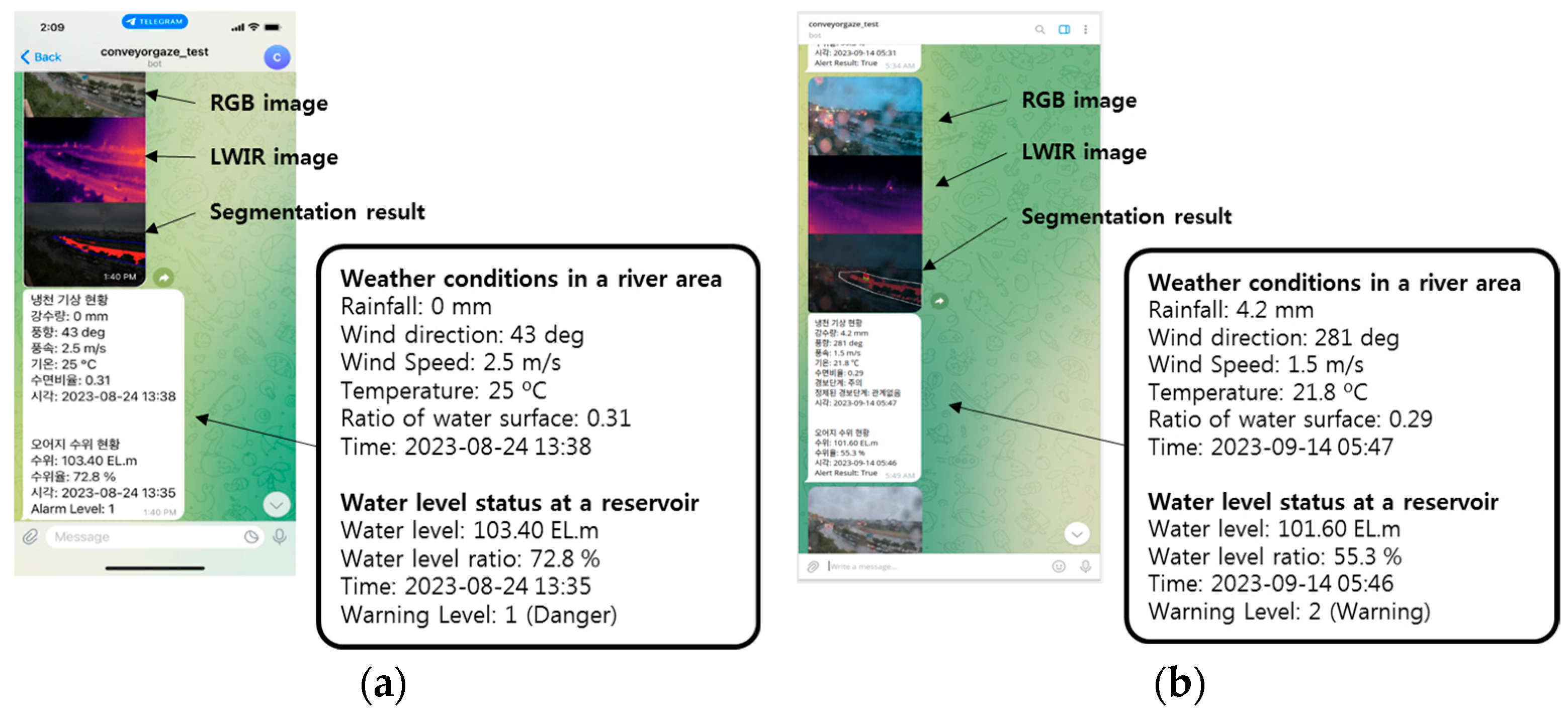
| Location 1 | Location 2 | Location 3 | Location 4 | |
|---|---|---|---|---|
| Daytime | 649 | 131 | 93 | 190 |
| Nighttime | 760 | 5 | 117 | 0 |
| Total | 1409 | 136 | 210 | 190 |
| Datasets | Training Set | Validation Set | Test Set |
|---|---|---|---|
| Collected | 1230 | 268 | 447 |
| Augmented | 1370 | 290 | 0 |
| Total | 2600 | 558 | 447 |
| NRGB | NLWIR | NFUSION | |
|---|---|---|---|
| Day | 90.39 | 83.77 | 91.00 |
| Night | 80.42 | 80.11 | 86.62 |
| Total | 87.53 | 82.86 | 89.80 |
| Models | mIoU | mIoU for Water | mIoU for Background |
|---|---|---|---|
| Baseline | 89.80 | 81.39 | 98.22 |
| 50% pruned | 89.63 | 81.05 | 98.50 |
| 60% pruned | 89.49 | 80.81 | 98.18 |
| 70% pruned | 90.05 | 81.83 | 98.27 |
| 80% pruned | 71.08 | 48.31 | 93.85 |
| 90% pruned | 63.99 | 33.64 | 94.34 |
| mIoU | Model Size | Param. Size | Speed (fps) | GFLOPs | |
|---|---|---|---|---|---|
| Baseline | 89.64% | 486.9 MB | 40.4 M | 1.02 | 74.48 |
| Slimmed_70 | 89.72% | 49.9 MB | 4 M | 12.69 | 22.87 |
Disclaimer/Publisher’s Note: The statements, opinions and data contained in all publications are solely those of the individual author(s) and contributor(s) and not of MDPI and/or the editor(s). MDPI and/or the editor(s) disclaim responsibility for any injury to people or property resulting from any ideas, methods, instructions or products referred to in the content. |
© 2024 by the authors. Licensee MDPI, Basel, Switzerland. This article is an open access article distributed under the terms and conditions of the Creative Commons Attribution (CC BY) license (https://creativecommons.org/licenses/by/4.0/).
Share and Cite
Lee, Y.J.; Hwang, J.Y.; Park, J.; Jung, H.G.; Suhr, J.K. Deep Neural Network-Based Flood Monitoring System Fusing RGB and LWIR Cameras for Embedded IoT Edge Devices. Remote Sens. 2024, 16, 2358. https://doi.org/10.3390/rs16132358
Lee YJ, Hwang JY, Park J, Jung HG, Suhr JK. Deep Neural Network-Based Flood Monitoring System Fusing RGB and LWIR Cameras for Embedded IoT Edge Devices. Remote Sensing. 2024; 16(13):2358. https://doi.org/10.3390/rs16132358
Chicago/Turabian StyleLee, Youn Joo, Jun Young Hwang, Jiwon Park, Ho Gi Jung, and Jae Kyu Suhr. 2024. "Deep Neural Network-Based Flood Monitoring System Fusing RGB and LWIR Cameras for Embedded IoT Edge Devices" Remote Sensing 16, no. 13: 2358. https://doi.org/10.3390/rs16132358
APA StyleLee, Y. J., Hwang, J. Y., Park, J., Jung, H. G., & Suhr, J. K. (2024). Deep Neural Network-Based Flood Monitoring System Fusing RGB and LWIR Cameras for Embedded IoT Edge Devices. Remote Sensing, 16(13), 2358. https://doi.org/10.3390/rs16132358






